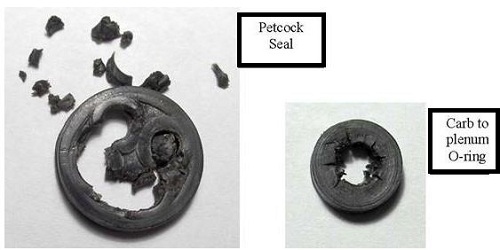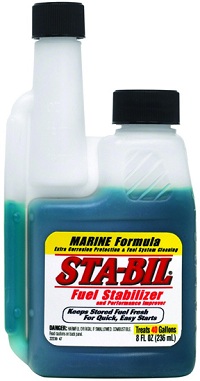When you go to the time, effort and expense to rebuild your carbs, they will have absolutely pristine innards. It would be a crime to connect them to a contaminated fuel tank. Now’s the time to evaluate the condition of your fuel tank. At a minimum, drain or siphon all the old fuel out. The drain plug is located near the rear master cylinder. Obviously, do this outdoors to avoid fire hazard.
Once the fuel is out, you can see the inside through the filler next with a strong flashlight (somewhat easier in a dark garage, so you may want to push the bike back indoors for this step). I usually remove the fuel sending unit for a better view inside the tank…but, this means you will need a new gasket for the sending unit. Note: the only sealant I’ve found that will prevent the threads of the drain plug from leaking (even with the OEM crush washer) is Permatex Aviation Form-A-Gasket No. 3 Sealant.
If your tank is rusty, bite the bullet and remove for cleaning and re-furb. This is a bear of a job…very time consuming. Consult your manual for complete details. Generally you will have to remove the following from the bike:
- Seat
- Rear Shocks
- Rear Wheel
- Rear Fender
- Rear Inner Fender
- Rear Master Cylinder (no need to disturb hydraulics)
- Final Drive Unit
- Petcock
You will also have to remove the 4 bolts which secure the top shelter (false tank). This is because the rear of the top shelter has to be raised slightly to allow the tank filler neck to slide to the rear. It helps to remove the battery box altogether, but this is not absolutely necessary.
Some manuals erroneously indicate that the swingarm and muffler have to be removed on a GL1000…this is not correct!
Tank Re-hab Products:
Since new fuel tanks cost $1000+ from Honda, rehabilitating your old tank is an economic necessity. Good commercial cleaning / protection products include:
- Rustol from Sudco: https://www.sudco.com/
- RUSTECO: https://www.rusteco.com/
- MOTORCYCLE TANK REPAIR from POR: https://www.por15.com/
- GAS TANK SEALER FOR MOTORCYCLES from Eastwood: https://www.eastwoodco.com/
- Rustbeeter: environmentally-friendly cleaning product made from a by-product of sugar beet-refining process: https://www.rustbeeter.com/ (cleaning product only…you will still need to treat/coat the cleaned tank)
- KREEM: available at any motorcycle shop (not my favorite)
Special Caution Regarding Kreem:
Kreem is a decent product. I’ve used it successfully on numerous occasions. The usual challenge is to follow the elaborate instructions carefully and completely. Inadequate prep results in the typical failure: the plastic lining’s adhesion will fail and the coating will separate from the inner surface of the tank. This makes for a huge headache!
A more insidious Kreem failure was discovered recently. If the prep is inadequate and the coating is allowed to “pool” and the tank is put back into service before the coating is fully cured, then methyl ethyl ketone (MEK) will leach into the gasoline in the tank. MEK is a powerful solvent that will destroy synthetic rubber components in your fuel system! Below are some actual examples of such real world failure. These reactions have been reproduced in lab testing.
Methyl Ethyl Ketone (MEK) Damage from Improperly Cured KREEM
(photo courtesy Tom Cox of Loveland, Colorado)
Methyl Ethyl Ketone is a commonly used solvent that has many properties that make it ideal medium for processing many organic compounds. MEK is an inert chemical that can hold a material in solution and evaporate leaving the soluble material behind unchanged. This makes MEK an ideal carrier for the polymers in tank coating products. Under normal circumstances the MEK would undergo the transformation from a liquid to a gaseous state and dissipate.
The first transformation in the curing process is for the coating to “skin” over and due to the porous nature of the polymer coating the solvent will continue to evaporate. Given enough time, the only thing left behind will be the desired coating. Evaporation slows as the cured surface thickens and creates the possibility that uncured solution can be trapped behind the surface. When the tank is filled and evaporation is no longer possible MEK can be released into the gasoline where it will remain an effective solvent that can act upon many of the common organic compounds that make up the seals and gaskets of a fuel delivery system.
Properly cured Kreem presents no such hazard, but the manufacturer was non-responsive to requests for more information on this issue. Use this product with great care!
Follow all product directions to the letter. I recommend blocking the fuel pick-up lines with lengths of insulated wire inserted after you remove the petcock. Make sure the product does not block the fuel inlet screens as it sets up.
Preferred Option:
Many good radiator shops are set up to service fuel tanks at reasonable cost. One good one is:
Elizabeth Radiator
1550 Hayden Boulevard
Elizabeth, PA 15037
(412) 384-5310
Bill Sovitski is the owner of Elizabeth Radiator. Bill offers excellent fuel tank repair at reasonable prices. He uses a plastic material called Red-Kote®which is superior to other methods. This process locks in surface rust and prevents further rusting. In addition to this coating service, he can help if you need more extensive tank repairs (radiator repair too!)
Bill’s method works and is my preferred fuel tank restoration option.
Not Recommended:
1. Some folks recommend cleaning rusty tanks with diluted muriatic acid (generally 1 part acid to 8 parts water). A full tank of this solution soaked overnight will definitely remove most surface rust. After the acid solution is drained, you flush with water then add alcohol to dry the inside of the tank. Some recommend blowing air through the tank with a shop vac to ensure thorough drying (may take several hours for complete drying). I don’t recommend tank cleaning with muriatic acid is a very hazardous substance. Also, it’s easy to remove more than rust and create holes which didn’t exist before (don’t ask!).
2. Others tout cleaning fuel tanks using electrolysis methods. Again, I don’t recommend this procedure. There are too many safety risks and serious health hazards.
Both muriatic acid and electrolysis do a decent job of cleaning, but unfortunately neither prevents the quick return of rusty surfaces. In fact, it’s next to impossible to prevent a “flash” of rust from reappearing after you’ve cleaned a tank with these methods. Worse, the type of rust that appears after both of these cleaning methods is the worst kind: microscopic rust particles that easily pass through any filter and go straight into your carbs! My advice: go with one of the commercial products listed above or send your tank out to an expert.
Final Advice:
-
Obtain and install a new rubber gasket for the fuel gauge sending unit before you reinstall your tank. These reliably leak when reused.
- Use STABIL brand fuel stabilizer in your fuel. Most GL1000s owners are busy, travel a lot and live in a climate with a real winter. They don’t ride their bikes nearly as often as they should. For these reasons, I recommend that you run the STABIL product year round. This will help you avoid problems with varnish gumming up your carbs from lack of use. I prefer the Marine formulation of STABIL. See my Tech Tip on Fuel and Fuel additives.
- Use Marvel Mystery Oil in your fuel. Follow the directions on the bottle for correct “recipe” which is 2 oz of MMO per 5 gallons of fuel. The will keep the internal, moving parts of you carbs lightly lubed. MMO is also very effective at retarding rust inside the fuel tank.
- If you can find the Marine formula of Stabil – it is preferred over the regular Stabil product. It has extra lubricating agents that protect fuel tanks. If you use Marine formula Stabil, you can skip the Marvel Mystery Oil.






Hi, I was just checking out your site and submitted this message via your “contact us” form. The contact page on your site sends you these messages to your email account which is why you’re reading through my message right now right? This is the most important accomplishment with any kind of advertising, getting people to actually READ your ad and I did that just now with you! If you have an ad message you would like to promote to tons of websites via their contact forms in the U.S. or to any country worldwide let me know, I can even target your required niches and my costs are super reasonable. Reply here: trinitybeumer@gmail.com
One good thing about Kreem – it can be fully removed with only acetone! I removed a very poorly applied Kreem coating from one of my GL1000 tanks by putting two gallons of plain acetone in it (all holes plugged, of course) and rolling it every day to a new position for about two weeks. I then poured out the mix, rinsed with about 1/2 gallon acetone then isopropyl. Luckily, the PO that Kreemed it had done a good job of cleaning the tank. I coated the interior with fogging oil and it then sat for three years until the rest of the bike was done. Still looked great (inspected with USB endoscope camera on coat hanger wire).
Hi Randakk,
I was wondering if Elizabeth Radiator is still in business for restoring gold wing gas tanks? If they are no longer doing this service do you know of anyone else who is cleaning rusty GL 1100 tanks.
Thanks, Paul harris. Brandon, Mississippi.
They are still in business.